Konica Minolta DiMAGE Z2 & Z3: What is the difference in performance?
by Stephen Caston on September 5, 2004 12:23 PM EST- Posted in
- Digital Camera
The Design: Konica Minolta DiMAGE Z2 and Z3
 Z2 Click to enlarge. |
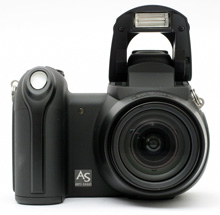 Z3 Click to enlarge. |
Although the Z2 and Z3 share many similarities, there are several major differences. The Z2 is made of slick plastic, which gives it a flimsy feeling, while the Z3 is made of rough plastic with rubberized panels. The Z2 has a lens capable of a 10X 38-380mm (35mm equivalent) optical zoom and the Z3 is capable of a 12X 35-420mm optical zoom. Both have a 4X digital zoom. The wide angle aperture range of both cameras is f2.8-8.0. However, the Z3's telephoto aperture range is a bit smaller at f4.5-8.0 compared to the Z2's f3.7-8.0. Both cameras have a shutter speed range of 30 - 1/1000 sec.
Above the lens on the Z2 is an "AF window" - a passive AF sensor. The Z3 uses a video AF system. Both cameras have removable lens caps. We found it kind of annoying that both cameras have a manual pop-up flash instead of having a button that would release the flash. This becomes not only cumbersome, but it also means that in Auto mode, the camera cannot automatically release the flash if it is needed for a proper exposure. You will notice that the flash on the Z3 opens to a higher position, allowing it to comfortably shoot over its lens. The Z2 has a larger flash range than the Z3. The instruction manual provides flash range figures for Auto Recording mode. The Z2 has a flash range of 0.75-20' in wide angle and 4.2-15.1' in telephoto, while the Z3's flash range is 0.70-13.1' in wide angle and 3.9-8.2' in telephoto. Both cameras have a self-timer lamp to the left of the lens. The Z2 also houses its microphone on this side.
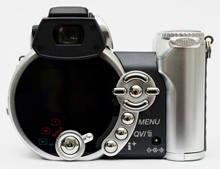 Z2 Click to enlarge. |
 Z3 Click to enlarge. |
The back of the Z2 and Z3 are very similar. Both cameras have a 1.5" LCD display. The display on the Z2 rereshes at 60 fps and the Z3 at 50 fps. With both cameras, action looks smooth on the monitor. The diopter adjustment for the Z2 is located on the left side of the viewfinder in the form of a very small knob, which we found very difficult to turn. The Z3 has a different diopter adjustment control that is equally as difficult to use. It is located just to the right of the viewfinder as a grooved wheel. The wheel is set too far into the camera to make it easy to turn. On both cameras, you have the option to view the LCD either via the monitor or through the viewfinder. This means that you can see all the same information through the viewfinder that you would on the traditional LCD monitor. The difference between the two cameras is that the Z2 utilizes Konica Minolta's Switch Finder system. The Switch Finder uses a mechanical process that blocks the LCD monitor with a mirror that reflects the image to the viewfinder. The Z3 is able to show the LCD image through the viewfinder without the mechanical process that the Z2 employs.
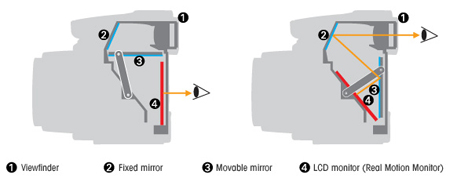
Switch Finder (Z2)
Image courtesy of Konica Minolta
The rest of the controls are exactly the same on both cameras. You have the option to turn the camera on in either Play mode, Record mode (LCD), or Record mode (viewfinder). To the right of the viewfinder is a 4-way controller with a separate "Enter' button in the middle. Below the directional buttons are the Menu, QV/Delete, and i+ buttons. Pressing the Menu button will display a menu that is specific to the current mode. Pressing the QV (Quick View)/Delete button in record mode will display previously taken pictures for review. Another press of the QV/Delete button will ask if you want to erase the picture. In play mode, the QV/Delete button only serves to delete pictures. The i+ button cycles through different overlay options in record and play mode. Just to the right of the i+ button on the Z2 is the port for the optional AC adapter. The camera's zoom controls are located in the upper right corner. The camera will zoom out if you slide the control to the left and zoom in if you slide it to the right.
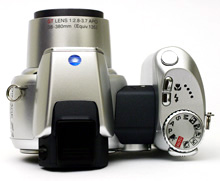 Z2 Click to enlarge. |
 Z3 Click to enlarge. |
On the top of both cameras is an accessory-shoe that fits the following Konica Minolta flash units: Maxxum/Program Flash 2500(D), 3600HS(D), and 5600HS(D). While not in use, the accessory-shoe is protected by a snug-fitting cover. To the right of the accessory-shoe is the shutter button, which is angled towards the front of the camera. Below the shutter button are the Macro button, Flash button, and Exposure-mode dial. There is only a minor difference in the layout of the Flash and Macro buttons between the Z2 and Z3. On the Z2, there is a speaker located on the far right side of the camera. The Z3 has both the microphone and speaker between the shutter button and the Flash and Macro buttons.
| Z2 | Z3 |
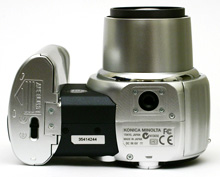 Click to enlarge. |
 Click to enlarge. |
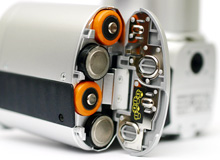 Z2 Click to enlarge. |
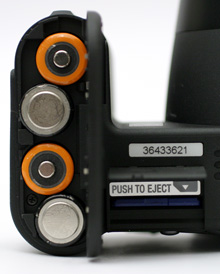 Z3 Click to enlarge. |
On the bottom of both cameras is a battery compartment inside the hand grip. On the Z2, there is a switch that locks and unlocks the door to prevent accidental opening. We did not find the absence of this lock to be a problem on the Z3. The battery door felt strong and secure. Both cameras use 4-AA batteries. Although alkalines were included with both cameras, we recommend using Ni-MH rechargeables. For our review, we are using 4-AA NiMH Power2000 2500mAh batteries. On the Z3, the slot for the SD/MMC flash card is located between the battery compartment and the tripod mount. The slot is hidden by a tiny spring action door. Directly below the lens is a metal tripod mount.
 Z2 Click to enlarge. |
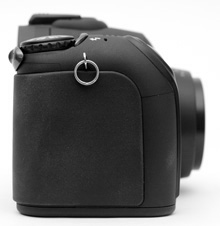 Z3 Click to enlarge. |
The only thing on the right side is one of the posts for the neck strap.
| Z2 | Z3 |
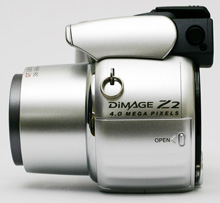 Click to enlarge. |
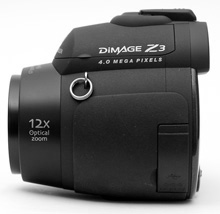 Click to enlarge. |
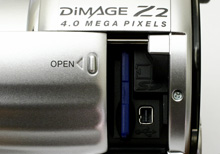 Z2 Click to enlarge. |
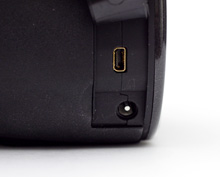 Z3 Click to enlarge. |
On the left side, the Z2 has a delicate sliding door that reveals the SD/MMC card slot and a combination USB and A/V port. The Z3 has a rubber tab that pulls back to access the combination USB and A/V port as well as a 6V DC jack. The other post for the neck strap is also located on this side.
Overall, both cameras have a very modern and sleek appearance, but the Z2 feels a bit delicate. The Z3, on the other hand, has a much more solid feel to it. The biggest design differences between these two cameras are the optical zoom, construction material, flash height, and other minor layout differences. Both cameras are quite compact considering that they have a 10X and 12X optical zoom. However, they are not small enough to carry around in our pocket. Yet, the large hand grip makes both cameras feel very secure in our hand. One thing that bothered us was the manual flash. It would be nice if Konica Minolta included a release mechanism to have easier and faster flash access.










9 Comments
View All Comments
PaulS - Tuesday, September 21, 2004 - link
Stephen, thanks for the information (and the review!). I'm looking at using either the Z2 or the Z3 for astrophotography where I would need detail derived from dark areas. I like the antishake and separate viewfinder that the Z3 offers, but I think from your comments the picture quality of the Z2 would be better.Thanks again!
stephencaston - Friday, September 17, 2004 - link
There are certainly ways to deal with some of the Z3's shortcomings by doing post-work. However, There isn't a way to deal with the loss of detail in shadow areas.The real question is what issues will a new firmware address? It will be interesting to see what Konica Minolta will do.
PaulS - Friday, September 17, 2004 - link
Until new firmware is released, is it possible to deal with Z3's flaws (e.g. under-exposure, darker images, colour reproduction) using standard image processing software?stephencaston - Thursday, September 16, 2004 - link
Kelh,Both cameras have an accessory shoe that fits Konica Minolta flash units: 2500(D), 3600HS(D), and 5600HS(D). However, these flash units are sold separately. I hope this answers your comment ;-)
Kelh - Thursday, September 16, 2004 - link
One of the things I never find in these reviews is wether the cameras include a flash stand. Sometimes the flashes that come with digicams are not good enough and night pictures look dark.joyce - Wednesday, September 15, 2004 - link
Is it worth the price difference?Here in The Netherlands the difference is about €140,=.
I think it is very much
microsaftcom - Monday, September 6, 2004 - link
what the reviewers call jpeg compression artefacts may be just normal noise... I don't know...Depends on the reviewers...
All cameras have some sort of horizontal lines...
I don't see when it will be a problem.
I think 3 mb for 4 Mpixel pictures show that the compression isn't very effective.
microsaftcom - Monday, September 6, 2004 - link
It seems that Z3's flaws can be dealt with with firmware updates.Perhapos that is why the current new firmware 1.01e is not official yet, even though it solved many problems.
In my mind these cams are uncomparable as one has image stabilisation and thoe other hasn't.
It has to be compared with the panasonic or the canon.
/F
Chaotic42 - Monday, September 6, 2004 - link
I had a Z2 for a brief period of time (I had to return it when my PSU killed my motherboard) and it was an awesome camera.The Z3 looks even better. I would recommend that anyone looking for a high-zoom camera check these out.